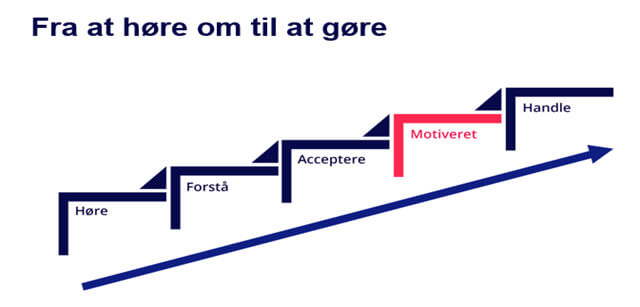White smoke, black tower — how do you get employees on your side?
Change is necessary in both public and private industry. It requires managers who are not only able to plot a course, but who also bring employees along for the ride. This article gives some concrete suggestions to what you can do to make this work.
“Black smoke, white tower. A long way to white smoke, black tower.”
Pernille Hebsgaard Rohdemeier, Senior consultant at Rhetorica
As some may remember, the quote above is a tweet from Margrethe Vestager, the former leader of De Radikale, the Danish Social Liberal Party. The tweet was sent during coalition agreement negotiations for the new government in September 2011. Negotiations took place at the tall, black Crown Plaza building on Amager. From her black tower, Margrethe Vestager had a view of the black smoke from a fire at the concert venue, KB Hallen, with the white tower of Danhostel on Amager in the background.
Margrethe Vestager personally declined to comment on the tweet, but many commentators interpreted it as an indication that a coalition agreement was a long way short of reached. The white smoke refers to the Vatican City, where white smoke from the Sistine Chapel informs the public that a new pope has been elected.
Maybe you are thinking, ‘What on earth does this have to do with change management?’ A lot, we think. Because the white smoke comes only after cardinals have been locked in for days without any contact to the outside world, who have absolutely no idea what has happened in the lead-up to the election of the new pope.
It takes repeated and persistent communication to go from telling employees what to do to getting them to adopt new behaviour.
In the same way, senior management often return from the strategy creation process telling the company’s employees in which direction they are expected to move. Senior management often assumes that employees — with the help of the strategy and a few communications products — will be able to begin implementing the new strategy straight away with no further help.
But if a manager adopts that approach, they underestimate the need to take their employees by the hand and show them the way.

It may sound trivial, but after working with processes of change in both public and private businesses, it is our experience that the desired change cannot be repeated often enough to employees. It is also our experience that managers often underestimate exactly that, partly because they were present in the tower during the strategy process, which led to the white smoke. When we advise managers in connection with implementing large changes in organisations, we often hear them say, ‘but we have communicated that. I have even been all around the organisation as a manager and presented the strategy to our employees.”
Making the effort to visit the whole organisation like that is in itself a time-consuming process, which makes most managers look despairingly at their calendars. Because of this, it is also completely understandable that most managers think that having done this, they are able to check communicating the strategy to employees off their to-do list. But we would be bad advisers if we let our clients stop there. Because when a manager thinks that things have been explained to employees a hundred times, you can be sure that many employees feel like they are hearing it for the first time, or even that they interpret it in a different way than management does.
There is a good reason for that, and it is not that employees are dragging their feet or have a hard time picking up new information. They are just not as far along in the process as you are. As the staircase below illustrates, it takes a while for us humans to be able to understand new information and take action after first being introduced to it. As you can see, it doesn’t occur overnight. You need to take that into account when implementing changes. As a manager, you need to communicate the new strategy at every available opportunity – both directly after launch and long term.
From hearing about information to acting on it
Hear > Understand > Accept > Motivated > Act

Link your strategy to reality
Persistent communication does not work by itself. The strategy and the desired behaviour should also be linked to reality and employees’ daily lives and be made as concrete as possible for them. So how do you do that? With the help of examples from their daily lives and accompanying descriptions of desired organisational behaviour down to employee level. Simply put, what should employees actually do differently to realise the strategy? What is their (altered) reality going to look like? What does the strategy actually mean for the agile project manager who needs to work more flexibly, or for the special consultant who needs to create proactive policy change?
What’s in it for me?
As you can see, motivated is highlighted in red in the model above. That is due to the fact that you need to motivate your employees if you want them to behave differently than usual. Simply put, managers need to offer an answer to the question: WIIFM? What’s in it for me? Maybe the answer is hard line — if an employee does not change, they will lose their job. That is also a source of motivation and a personal reason for changing behaviour. But maybe you can also offer some reasons for why changes will help employees by perhaps making tasks easier and quicker for employees than they are currently?
Address concerns
By now it is a slightly worn out cliché that humans by nature are scared of change and therefore fight against it almost out of principle. But large changes do usually lead to both advantages and disadvantages for individuals. As receivers of the strategy, it can be hard to understand and grasp the sales talk and all the good aspects of the strategy if you are preoccupied with objections and concerns.
Has something similar been tried unsuccessfully? Do employees lack the time or skills to bring about change? Why are some procedures going to be quicker? Is it for example because of an introduction of machines into the accounting department in order to cut down expenses on employees? Here, a manager has to remember that those accounting employees at risk of being fired will clearly have a problem with accepting the message communicated from management, if the strategy is only discussed as a benefit for all.
So regardless of whether concerns are real or not, a manager needs to address them if they want to succeed in communicating the strategy and thereby also in making a change.
It’s important to acknowledge concerns and, if possible, explain how they will be addressed.
The long haul
If you have read this far, you are now painfully aware that there are no quick solutions when a manager needs to succeed in implementing change. It’s the long and tough haul which determines whether a manager will succeed with communication and change, or if everything will go back to business as usual after the launching of the new strategy. The only quick fix we can offer with regard to this, is the following overview of the key points and advice regarding change management covered in this article.
- Take your employees by the hand and lead them on the journey. It takes time and several stops along the way.
- Repeat yourself and be persistent in your communication. Seize every available opportunity to communicate to employees — also long-term.
- Motivate your employees by offering answers to what they — and not just the organisation — will gain from the changes.
- Make the strategy concrete and relate it to your employees’ everyday lives and challenges. What are they actually going to be doing differently?
- Address counterarguments, acknowledge concerns, and, if possible, provide a solution to them.